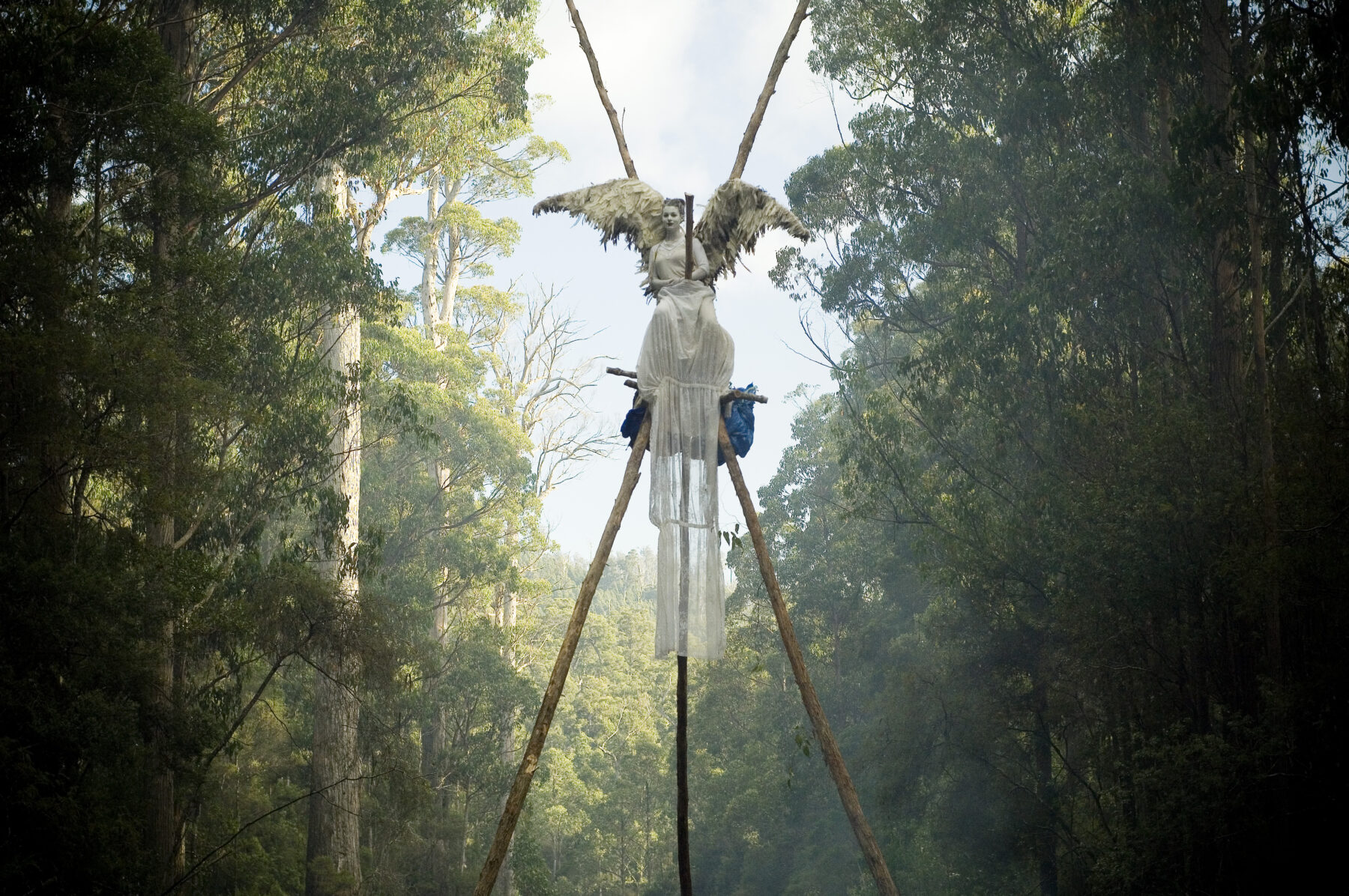The photo of the Weld Angel brought the fight to protect Tasmania’s Southern Forests to the world. It appeared in a number of international television broadcasts and the pages of major newspapers and magazines such as Le Figaro and Vanity Fair Italia, well before the issue was covered by Australian media.
Photographer Matthew Newton has been documenting the ongoing struggle for Tasmania’s forests for 20 years and the 2007 Weld Angel image demonstrates the power of high‑quality photography when it’s combined with theatrical activism.
Photography played a pivotal role in earlier campaigns to protect Tasmania’s wilderness: Olegas Truchanas’s slideshows celebrated Lake Pedder before it was flooded; Peter Dombrovskis’s iconic image Rock Island Bend, Franklin River, Tasmania, was critical in saving the river from being dammed; and Matthew’s two decades of reportage from the frontlines of the so-called forest wars have been published in books and won photographic competitions.
The Weld sits together with the Styx and Florentine valleys in the Southern Forests of Tasmania in a secluded wilderness region, two hours drive west of Hobart. This old-growth forest hosts the planet’s tallest known flowering tree species, the mountain ash (Eucalyptus Regnans). With their pristine natural beauty and ecological significance, the Southern Forests’ mountain ash trees became central to battles to save these habitats, which raged for decades between the logging industry and environmentalists.
Battles to protect Tasmania’s natural heritage had been running since the 1970s, after distress over Lake Pedder gave rise to an organised protest movement. In the early 1980s this was followed by a successful campaign to protect the Franklin River, before the debate switched to the forestry industry.
By the early 1990s, coverage of the highly polarised fight between foresters and greenies had waned, so to garner greater media attention, activists engaged in increasingly dramatic and creative protests, including “tree sits”.
In 2006, clearfell logging for woodchips intensified in the Weld Valley, which made it the focus for protests and a blockade that ran for many months. During this time, Tassie’s then-biggest company and the nation’s largest woodchip exporter, Gunns Limited, attempted to silence public opposition to its clearfelling of old-growth forests by suing a group of 20 conservationists who became known as the Gunns 20, including famed environmentalist Bob Brown, founder of Australia’s Greens political party.
Another protester was Allana Beltran, a former student at Sydney College of the Arts. During 2006 she lived for months at a time on suspended platforms 40–50m above the ground in the Weld Valley, as part of a community intent on stopping the entry of heavy logging machinery. In 2007, Allana and her then-partner, Ben Morrow, after being ejected from the site during one of numerous police raids, planned an elaborate piece of performance art that would obstruct both roads into to the logging site.
Matthew Newton was tipped off about it the night before by the activists and he arrived in time to capture the early morning arrival of 60 police. Blocking one entry to the site was Allana, with a long white curtain draped around her waist, her face painted white, wearing wings of white cockatoo feathers and strapped to a giant tripod suspended 10m in the air. Despite police shouting at her through megaphones, Allana remained in position for 10 hours, listening to Tibetan monk music through headphones. Her partner, Ben, blocked the other entry point, hanging from a bridge over the Weld River. The performance protest saw Ben sued by Tasmania Police and the state logging agency, while Allana was pursued for $10,000 costs – both actions failed. The police famously included the price of their lunch and coffee in the action.
In the following years, copycat angels appeared in protests around the country. The visual spectacle of Allana’s performance, combined with the absurdity of the ensuing court cases, brought the fight to save Tasmanian forests to world attention. Today, parts of the Southern Forests – including where Allana hung suspended – are included in the Tasmanian Wilderness World Heritage Area, having been added in 2013. A small portion of the lower Weld Valley continues to be logged.
Tasmania’s Weld Angel: A forest saviour
Matthew Newton’s haunting image became a potent symbol of the anti-logging movement that helped save Tasmania’s Weld Valley forest.
By
Nicky Catley
•
22 May 2023

Matthew Newton’s 2007 photograph entitled Weld Angel became one of the most recognisable images from Tasmania’s “Forest Wars”. Allana Beltran’s art performance and anti-logging protest attracted international media attention.